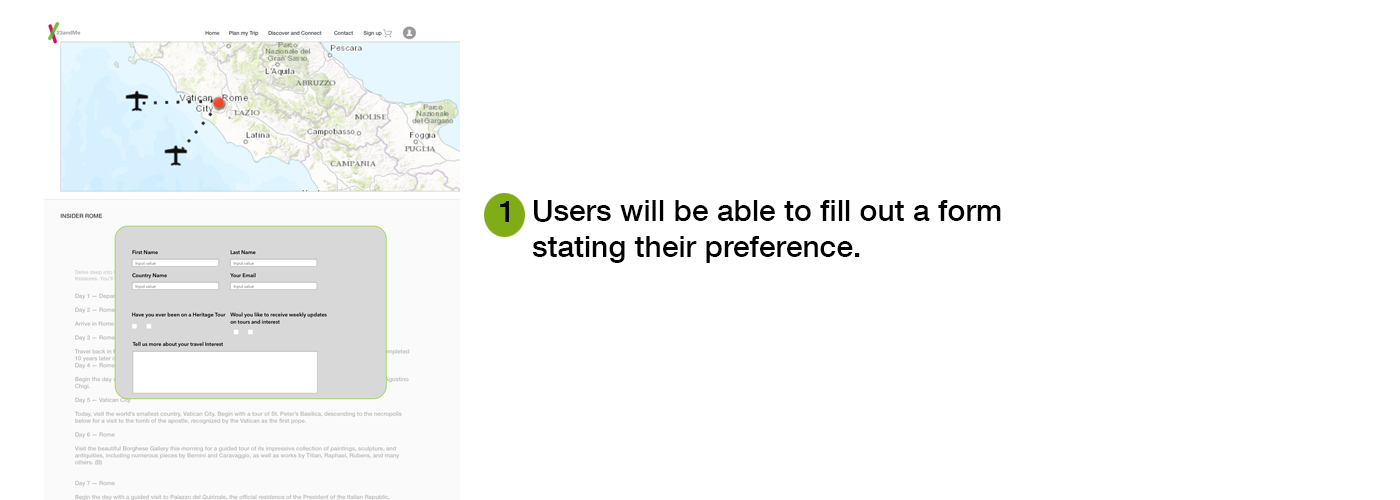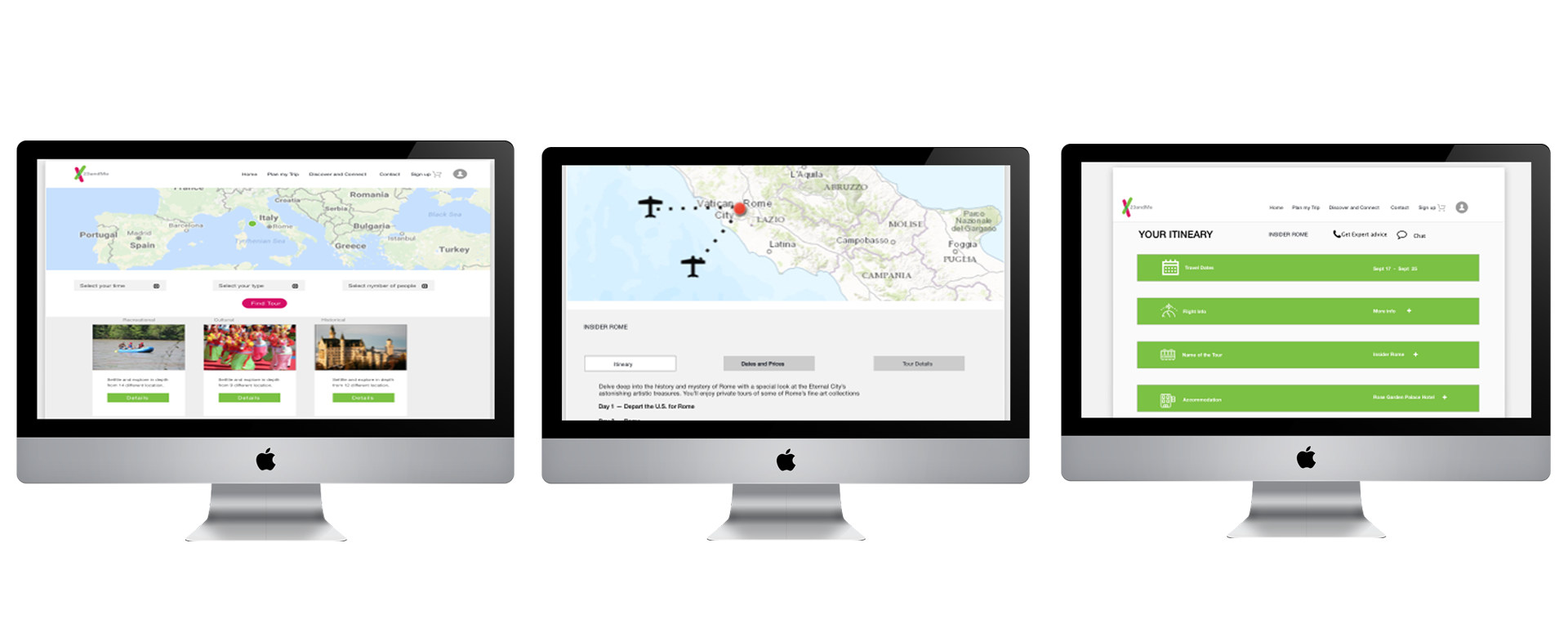Client
Heritage tourism is on the rise as millions of Americans research and analyzes their DNA through companies like 23andMe and travel back to their homeland. DNA testing can reveal ethnic mix and ancestors in our past. Currently, 23andMe provides tools for understanding health and ancestry. The company is exploring ways to open up DNA tourism for its consumers.
My team and I were asked to create a web prototype for 23andMe to encourage DNA tourism for its consumers.Finding out where we come from can give roots, solidity, and meaning to our lives. and solve the mystery of who we are.
The Problem
To find a personalized travel experience based on DNA discovery that would provide a unique map to connect and discover ancestry.
The Solution
We designed a website application that would provide a streamlined experience by allowing the users to select lineage country based on DNA testing, authentic travel experience by customized planning and family connectivity through suggestions of distant relatives.
I led the design, research and strategy of the Travel experience for the new product.
I decided to follow Design thinking approach to define the problem space and was keen on finding a solution through deep insights of user data from people who have already done DNA testing with 23andMe.
Problem Space Exploration
BRAINSTORMING

At the outset of the project, we didn't have any clear mission or goals about what kind of travel experience a person would look for in a heritage journey.
To determine a clear goal of the project, me and my colleague brainstormed ideas, developed personas, and empathy map.
By taking deeper dive to understand the real customer dissatisfaction from our persona's and empathy map we were able to define our problem.

Persona
The three personas below were a synthesis of 6 user interviews.



By synthesizing the persona and user interviews, we were able to figure out the emotional and functional criteria of our users.
Functional Criteria
- Being able to select the right country was imp
- To travel to gain and share knowledge of ancestry with children
- To gain knowledge of ancestry as a hobby
Emotional Criteria
- Being able to stay where the ancestor lived
- Family connectivity and Knowledge about family
- Communication with relatives
- Ability to share an experience online
- Passing information about ancestry to children
These criteria led us to the key high-level tasks the user wants to achieve when using our product. By understanding the overarching goals we focused on creating the best user experience.

Secondary Persona
I decided to conduct further interviews to focus on the key high-level tasks the user wants to achieve when using our product.
Further user interviews were conducted with people who have already tested DNA with 23andme to supplement my research of user needs. Kelly's persona was created with the intention of guiding me throughout my project in design decisions and solving Kelly's needs.
In my second round of interview with Kelly, I found that she is a Busy professional.
- She has already sequenced her DNA with 23 and me. She values family relationship but doesn’t have the time to call or connect.
- She values family trips, learning about her heritage and also interested to connect to her roots
- Wishes for a great trip where she could experience her ancestry
- Wishes to meet her distant relatives on the trip.

Challenge
The challenge was to create a product that would personalize a travel experience with the ability connect with the family members and fine-tune customized tours to satisfy the user’s need.
Research and Discovery
The following quotes holistically guided our research.
"I want to get an experience of where my ancestor lived. I want to know what it would be like for me to live there at this point in time”
We began brainstorming 4 problem areas, Efficient planning, option based on demographics, family connectivity, Making adjusting trip planning easy. Through rapid paper prototyping, affinity mapping, optimal card sorting, we were able to define product categories, find common trends, discover new problem areas.
Discovery
I started the process by making my paper prototype, optimal card sorting, and initial sketching. After testing the paper prototype with users, we discovered different kinds of problems.
We realized from user’s feedback that the prototype had too many features and it was confusing the users. It became clearer that travelers expected great travel experience with minimum effort.

Through competitive analysis, I discovered few important features. The company only had one competitor. Upon analyzing their site, I discovered they provided personal and group travel. They provided a way to share personal stories. They didn't have any tour options based on demographics.
Research findings
Using the competitive analysis, affinity maps key points were discovered.
1. Users had limited time
2. Users didn’t want to go through many tour options
3. Users were frustrations with many choices of places to stay
The following takeaways were discovered upon comparing business goals with the User goal

- Bring the user return to the country being discovered
- Make user travel to other lineage countries
- Make the user knows about tour options
- Allow options for users to meet distant family on the trip
At this point in our research, it was obvious that our solution should focus on minimizing the confusion for users. This was a great opportunity to perfect the travel experience by limiting choices allowing choices based on demographics.
3. Design and Test
With further iteration tour options and activities were limited to reduce confusion.

In building a product for 23and me, I envisioned customized planning and family connectivity. I brainstormed key features for the product that was essential to meet user need.
The key features to include were
- The user should be able to see planned group tours based on the country of selection and other lineage related countries. The user should able to customize the planned tours. There should be option to keep some of the features and modify others.
-Having a feature that would suggest the Airbnb, Villas close to ancestral was important to take future trips.That experience was important for connecting to lineage.
Having a feature that recommends all the distant relative on the same trip was also important to users.
Fine Tuning
Digging into the data revealed some big insights.
Providing a trip with few options with the ability to fine tune optimized the travel experience.
With all the features in mind, a user flow was created.

Usability Testing
Based on the userflow, wireframes were created and tested with the users. There were three primary components that needed to be addressed.



















Heritage Journey
A personalized authentic travel experience that gives a unique map to connect with our heritage